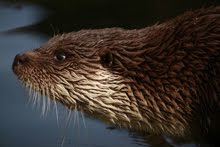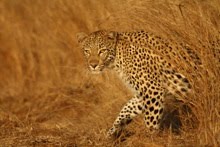Rarity birds should be photographed, not used for refining your technique ;-)
That is why you go digiscoping at your local duck pond (part 1) and digiscoping-friendly zoo (part 2) are for.
 Crested Barbet (Trachyphonus vaillantii) on a rusty pole. I like the way the rust reflects the colour of the bird.
Crested Barbet (Trachyphonus vaillantii) on a rusty pole. I like the way the rust reflects the colour of the bird.But another great place to get lots of digiscoping practice in is in your own garden, or a garden of a friend. There is tons of great info on how to attract birds to your garden, from bird feeders and bird baths, to selecting appropriate trees and shrubbery, and how to build a garden pond that attracts and entire bird-friendly ecosystem.
Bird feeder / bird bath
A bird feeder or bath provides a regular attraction to birds.
 View of my parents’ garden feeder looking through the lounge window. It is cold outside and I was lazy so I stayed indoors. The room is darkened to minimize reflections on the glass.
View of my parents’ garden feeder looking through the lounge window. It is cold outside and I was lazy so I stayed indoors. The room is darkened to minimize reflections on the glass.- Create a natural looking setting for your photographs by using natural materials (wood, sticks, boulders, etc) or structures that appear natural (e.g. fiberglass stones). This will give you a lot more scope in taking and framing your photographs.
- Watch the light. Place your bird feeder or bird bath somewhere useful so that the light is in a good position at the time of day you will generally be taking photographs (normally earlier morning or later afternoon).
- Avoid artificial objects in the shot. If you can. If you can’t then go ahead and have fun practicing with the plastic dish/plastic bird feeder in the shot - the practice is what counts!
- If you have an artificial looking feeder, then set up a branch nearby for the birds to land on and you can take photos of them there.

Pair of African Red-eyed Bulbuls (Pycnonotus nigricans)
Natural vegetation
- Choose locally indigenous plants
- Focus on plants that produce flowers and fruits that attract birds
- It never hurts to have trees, bushes or grasses that make good nesting material
- Structural heterogeneity. I can’t stress this enough – the more vertical layers you have, and the more different types of vegetation you can offer, the greater the species diversity.
- Dead leaves are your friend. Mulching will both help your garden flourish and provide great habitat for robins, thrushes and other ground insectivores.
 Cape Robin-chat (Cossypha caffra) on the feeder. Notice the apple in the background. This could either be darkened in photoshop to make it less obvious, or better still would have been to frame the original photo better so that it did not include apple bits.
Cape Robin-chat (Cossypha caffra) on the feeder. Notice the apple in the background. This could either be darkened in photoshop to make it less obvious, or better still would have been to frame the original photo better so that it did not include apple bits.Build a pond
Ponds create great natural ecosystems for a variety of birds (and other cool creatures). There are tons of pond experts out there, but you might want to spend some time exploring Mike’s „Weedon’s World of Nature“ blog. Mike has tons of tips and encouraging info on how to create a wonderful garden pond.
If you know of any other great pond blogs/sites, please leave their addresses in the comments section.
 I really liked this shot – the only thing in focus is the crazy un-attached eye. African Red-eyed Bulbul.
I really liked this shot – the only thing in focus is the crazy un-attached eye. African Red-eyed Bulbul.Happy digiscoping,
Dale Forbes







.jpg)



.jpg)








.jpg)



5 comments:
Some wonderful info with this Dale. I want to try to find the time to phone you during the next two days. I am glad you brought some warmer weather with you. That icy wind was driving me nuts. LOL!!
Excellent advice Dale. Enjoy your months in SA.
I never seen such a lovely bird.
Alternative energy
Lovely birds Images.
Well done Dale.
John
Great images Dale and wonderful tips,
Also do you think a straight scope will give you sharper images than an angled do to the angle of the prisim in the scope?
Kev
Post a Comment